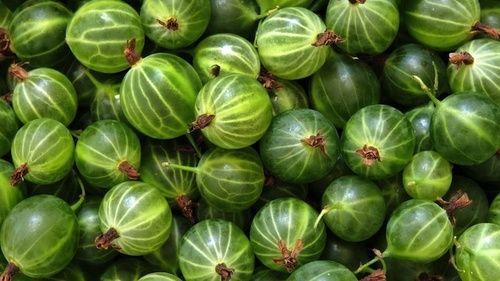L'gooseberry is the fruit of the plant Ribes grussularia. Rich in vitamins and polyphenols, and diuretic, detoxifying and helps to counteract skin aging. Let's find out better.
> 1. Properties and benefits of gooseberries
> 2. Calories and nutritional values of gooseberries
> 3. Ally of
> 4. Description and variety of the plant
> 5. Curiosities about gooseberries

Properties and benefits of gooseberries
The gooseberry fruit is very rich in active ingredients such as vitamins (including Vitamin C) but also fibers and pectins, organic acids such as malic, salicylic and tartaric as well as different types of polyphenols.
It has several properties in common with the other fruits of the undergrowth, plus some specific effects for each fruit. Studies conducted within the InterBerry project (Integrated Interdisciplinary Project for the Qualitative Improvement of Small Fruits and the Study of New Processing Products with High Added Value) have, in fact, allowed to characterize in 2004 a total of 271 samples of small fruits of different varieties for the total content in reactive polyphenols and 248 fruits for the total content in Anthocyanins.
In general, a considerable variation in concentrations was observed according to the species and in many cases also according to the different cultivars.
From the analytical data obtained, the berries with the highest total polyphenol content appeared to be the black currant with about 5.700 mg / kg, followed by strawberry with 5.000 mg / kg, red currant (3.700 mg / kg), blackberry (3.500 mg / kg), white currant (3.300 mg / kg), giant blueberry (3.200 mg / kg), white raspberry (2.400 mg / kg) and red raspberry (2.000 mg / kg).
Lower average contents - albeit still very significant compared to fruit in general - were recorded for red gooseberries (1.700 mg / kg), white gooseberries (1.600 mg / kg) and finally for strawberries (1.500 mg) / kg).
Calories and nutritional values of gooseberries
100 g of gooseberries contain 44 calories.
Furthermore, for 100 g of product we have:
- Lipids 0,6 g
- Sodium 1 mg
- Potassium 198 mg
- Glucid 10 g
- Dietary fiber 4,3 g
- 0,9 g protein
- Vitamin A 290 IU
- Vitamin C 27,7 mg
- Calcium 25 mg
- Iron 0,3 mg
- Magnesium 10 mg
Ally of
Like other berries, gooseberries add to the low calorie intake (about 40 kcal per 100g of fresh fruit) also a series of characteristics that make this fruit an excellent ally for the health and well-being of our body. Especially since the sugars they contain (levulose and glucose), responsible for their sweetness, are also tolerated by diabetics (as long as you don't overdo it).
Only those who are predisposed to allergies or those suffering from diverticulosis must be cautious in their consumption or, at times, even do without them since the berries have a full pulp and rich in precious seeds that can be deposited in the diverticula.
It is above all the abundant content of phytochemicals (such as flavonoids and anthocyanins) and vitamin C that determine most of the beneficial actions common to these fruits. The gooseberry has, in fact, important properties such as that of stimulate the body's defenses, protecting against infections, purify and detoxify the blood from contamination due for example to heavy metals by taking half a glass of fresh fruit juice every 10-12 hours. This is thanks to the flavonoids contained that contribute to the good functioning of the liverhelping him to dispose of excess toxic substances.
Being diuretics and detoxifiers, as well as antioxidants, their activity is manifested against the negative effects of free radicals slowing down cellular aging, which affects both the state of the skin and the risk factors related to degenerative diseases.
They are nutritious, refreshing and astringents, useful for rebalancing intestinal functions, also thanks to the fibers (including pectin), contained in good quantities, which among other things help to control the level of cholesterol.
Other merits of the gooseberry are those of its berries having a remarkable thirst-quenching power and stimulate the production of gastric juices, acting as an aperitif or digestive.
You can take advantage of all the causes and natural remedies for difficult digestion

Description of the plant and variety
Gooseberry (Ribes grossularia) is a close relative of the currant which, wanting to distinguish itself from the "red" and "black" ones, decided not to be satisfied with tiny berries in clusters but to invent large berries with a spherical or elongated shape, resembling a grape, covered by a spiny green hair that then tends to yellow or red when it is about to ripen.
It is a currant so different from the other two (with berries that reach even 2,5 cm in diameter) that it is called, with popular names, uva crispa, grape of the friars, grape marine, grape spinella, wild grapes, raisins.
The taste is aromatic, sweetish and very particular (slightly acidulous), in fact not everyone likes it. In general, the optimal organoleptic qualities are always reached when the fruit is fully ripe.
The derivation of the name is not entirely certain but the most accredited traces the term “currant” to the Arabic ribus, meaning “plant with acidic fruits”.
The cultivation of gooseberries dates back to 1700 when in England there were already hundreds of crops that soon spread to other European countries, especially in Germany where its cultivation is quite widespread.
The Currant grossularia is present throughout Europe ma dimostra una decisa predilezione per il clima del paese, per quello francese e per la Spagna; lo ritroviamo anche in Africa del nord e sulle montagne dell’Asia, nei luoghi meno caldi e assolati, nei boschi di pianura e sino a duemila metri di altitudine.
In the village, gooseberries are difficult to find (they are found in bushy places, at the edge of the woods, in stony places and can reach an altitude of 1700 meters) because the environmental degradation and the little care that is reserved for the undergrowth have spontaneous diffusion is limited and cultivation is restricted in plants of limited size or in family orchards.
Curiosities about gooseberries
It is not advisable to eat unripe gooseberry berries (moreover unpleasant) because they can cause slight intestinal disorders, while if well ripe they exhibit all their beneficial properties.
Their juice drunk in the morning, on an empty stomach, is an excellent purifying treatment, beneficial against overweight and excellent in the convalescence phase because it restores the right balance of mineral salts in the body (remineralizing action).
Gooseberries are eaten fresh (for fruit salads and dessert decorations, or to garnish meat or fish dishes or in salads) but for their sour taste, gooseberries are suitable for being transformed into syrups, jellies, jams (also because when fresh fruit is scarce in winter, we can always have it available thanks to these ways of preserving it).
READ MORE
Gooseberries among the fruit and vegetables of August
| Wallpapersus.com


























